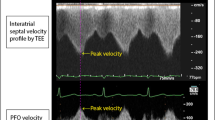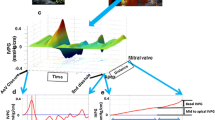Abstract
Although very high gradient levels were measured during the evaluation of ventricular septal defect (VSD) in daily practice, these measurements are generally interpreted as erroneous and thus neglected. Our aim was to assess the features of VSD’s having erroneous interventricular pressure gradients by echocardiography. A 46 patients were enrolled in the study. The patients with higher Doppler-derived interventricular gradient than brachial systolic blood pressure were compared with patients with lower gradient (group 1, n = 26; group 2, n = 20, respectively) in terms of echocardiographic characteristics of VSD. No significant relations were observed in systolic and diastolic blood pressure and interventricular synchronicity between two groups (117.1 ± 6.7 vs 110.2 ± 6.3 mmHg, p = 0.145; 74.7 ± 4.3 vs 73.2 ± 4.9 mmHg, p = 0.32; 31.2 ± 5.5 vs 33.2 ± 4.9 msn, p = 0.29, respectively). Left ventricular end-diastolic and end-systolic diameters were greater in group 2 (46.6 ± 3.5 vs 49.5 ± 4.5, p = 0.022; 30.3 ± 2.5 vs 32.9 ± 3.2, p = 0.004, respectively). Doppler-derived interventricular pressure gradients were significantly higher in group 1 (144.4 ± 13.6 vs 75.7 ± 5.1 mmHg, p < 0.001, respectively). Defect width was significantly lower (3.20 ± 0.40 vs 4.8 ± 1.8 mm, respectively, p < 0.05), and length was greater in group 1 patients (5.75 ± 0.90 vs 2.80 ± 0.80 mm, p < 0.05, respectively). There was a significant positive correlation between pressure gradient and defect length (r = 0.84, p < 0.001), and a negative correlation between pressure gradient and defect width (r = −0.66, p < 0.001). Defect length/width was significantly greater in group 1. With the cut-off value of 1.2, defect length/width was able to predict tunnel-type VSD with sensitivity of 88.5 % and specificity of 72.7 %. Continuous-wave Doppler method may overestimate interventricular pressure gradients in patients with tunnel-type ventricular septal defect.



Similar content being viewed by others
References
Ammash NM, Warnes CA (2001) Ventricular septal defects in adults. Ann Intern Med 135(9):812
Marx GR, Allen HD, Goldberg SJ (1986) Doppler echocardiographic estimation of pulmonary artery pressure in pediatric patients with ventricular communications. J Am Coll Cardiol 6:1132
Matsuoka Y, Hayakawa K (1986) Noninvasive estimation of right ventricular systolic pressure in ventricular septal defect by a continuous wave Doppler technique. Jpn Circ J 50:1062–1070
Grossman W (1991) Shunt detection and measurement. In: Grossman W, Baim DS (eds) Cardiac catheterization, angiography and intervention, 4th edn. Lea & Febiger, Philadelphia, PA, pp 166–181
Kern MJ (2011) Hemodynamic data and basic electrocardiography. In: Kern MJ (ed) The cardiac catheterization handbook, 5th edn. Saunders-Elsevier, Philadelphia, p 112
Yoganathan AP, Valdes-Cruz LM, Schmidt-Dohna J et al (1987) Continuous-wave Doppler velocities and gradients across fixed tunnel obstructions: studies in vitro and in vivo. Circulation 76(3):657–666
Baumgartner H, Stefenelli T, Niederberger J et al (1999) “Overestimation” of catheter gradients by Doppler ultrasound in patients with aortic stenosis: a predictable manifestation of pressure recovery. J Am Coll Cardiol 33(6):1655–1661
Barker PC, Ensing G, Ludomirsky A et al (2002) Comparison of simultaneous invasive and noninvasive measurements of pressure gradients in congenital aortic valve stenosis. J Am Soc Echocardiogr 15(12):1496–1502
Stewart WJ, Schiavone WA, Salcedo EE et al (1987) Intraoperative Doppler echocardiography in hypertrophic cardiomyopathy: correlations with the obstructive gradient. J Am Coll Cardiol 10:327–335
Baumgartner H, Khan S, DeRobertis M et al (1990) Discrepancies between Doppler and catheter gradients in aortic prosthetic valves in vitro: a manifestation of localized gradients and pressure recovery. Circulation 82:1467–1475
Baumgartner H, Khan SS, DeRobertis M et al (1992) Effect of prosthetic aortic valve design on the Doppler-catheter gradient correlation: an in vitro study of normal St. Jude, Metronic-Hall, Starr-Edwards and Hancock valves. J Am Coll Cardiol 19:324–332
Montiel-Trujillo A, Rodríguez-Bailón I, Alonso-Briales JH et al (2008) The pressure recovery phenomenon in an interventricular septal defect with a high pressure gradient. Rev Esp Cardiol 61(7):783–784
Baumgartner H, Schima H, Tulzer G et al (1993) Effect of stenosis geometry on the Doppler-catheter gradient relation in vitro: a manifestation of pressure recovery. J Am Coll Cardiol 21(4):1018–1025
Parnell A, Swanevelder J (2009) High transvalvular pressure gradients on intraoperative transesophageal echocardiography after aortic valve replacement: what does it mean? HSR Proc Intensive Care Cardiovasc Anesth 1(4):7–18
Niederberger J, Schima H, Maurer G et al (1996) Importance of pressure recovery for the assessment of aortic stenosis by Doppler ultrasound. Role of aortic size, aortic valve area, and direction of the stenotic jet in vitro. Circulation 94:1934–1940
Baumgartner H, Hung J, Bermejo J et al (2009) Echocardiographic assessment of valve stenosis: EAE/ASE recommendations for clinical practice. American Society of Echocardiography; European Association of Echocardiography. J Am Soc Echocardiogr 22(1):1–23
Mercer-Rosa L, Seliem MA, Fedec A et al (2006) Illustration of the additional value of real-time 3-dimensional echocardiography to conventional transthoracic and transesophageal 2-dimensional echocardiography in imaging muscular ventricular septal defects: does this have any impact on individual patient treatment? J Am Soc Echocardiogr 19(12):1511–1519
Chen FL, Hsiung MC, Nanda N et al (2006) Real time three-dimensional echocardiography in assessing ventricular septal defects: an echocardiographic-surgical correlative study. Echocardiography 23(7):562–568
Conflict of interest
None.
Author information
Authors and Affiliations
Corresponding author
Rights and permissions
About this article
Cite this article
Akgun, T., Karabay, C.Y., Kocabay, G. et al. Discrepancies between Doppler and catheter gradients in ventricular septal defect: a correction of localized gradients from pressure recovery phenomenon. Int J Cardiovasc Imaging 30, 39–45 (2014). https://doi.org/10.1007/s10554-013-0291-x
Received:
Accepted:
Published:
Issue Date:
DOI: https://doi.org/10.1007/s10554-013-0291-x




